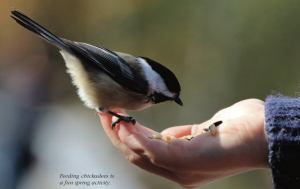
Fun activities to introduce a new generation to the marvels of the outdoors.
There’s nothing like sharing the wonders of springtime with youngsters. Little people tend to have big questions and boundless curiosity, so a walk in the woods, an adventure at the park or a glorious splash through puddles can transport you to unexpected realms. One minute you may be playing the part of a dragon or dinosaur in a make-believe jungle, while the next you’re apt to be grappling with broad topics: “Why is the sky blue? Why do some trees grow leaves while others don’t?”
Since there are endless marvels to witness and investigate, each outdoor adventure is an opportunity to show and teach appreciation for the natural world. For instance, you can point out animal tracks in the woods and stop to examine them. Ask your young companions if they notice the scent of pine needles or if they can identify a sound in the distance. Is it a bird? A chipmunk? It can be fun to speculate and to find out.
You can also make a forest hike extra special by turning it into a treasure hunt. While indoor objects, such as a bright pencil case or a familiar toy, can be hidden in the landscape and itemized on a “map,” there’s also a fuss-free option. List items, such as moss, flat rocks, tree roots, bark and nests, that may be found in the setting. The aim, though, is to enjoy the search and to discover other surprises along the way. Pretty soon kids will be noticing that, even without foliage, bare-limbed trees and bushes vary widely in colour and texture and shape. Try describing what you see or, better yet, recording it.
 Nature Journaling
Nature Journaling
Nature journaling is an annual spring activity for Jacquelyn Toupin’s family. “It’s a low maintenance, simple way for us to spend time together in the fresh air,” she points out. Inexpensive notebooks are purchased and can be decorated. With notebooks and pencils in hand, youngsters and oldsters then head outdoors to discover what’s new.
“There are many different milestones of spring to observe and record,” Jacquelyn explains. “Often we begin by noting what’s new about the day.What things can we hear, touch, see, and feel that are different than on our last walk? That little green shoot we saw just inching through the dirt yesterday? It’s standing taller today, and we think it could be an onion from last year’s bulbs!”
Descriptions, impressions, facts, stories and drawings may find their way into a journal. Later, these recordings can serve as the starting point for discussing and exploring topics of interest, when notes and discoveries are compared.
“As the days go by, our nature journals become chronicles of everything the world beyond the front step has to offer us,”says Jacquelyn.“In taking the time to witness these small changes, we learn to slow down and appreciate the beauty of something small yet great.We become more mindful with the realization that we are part of something much bigger than ourselves, and I hope, in time, this fosters a sense of environmental responsibility.”
Feeding the chickadees
For another fun experience, take the youngsters on a hike to feed chickadees. Popular spots to do this include the Jack Pine Trail off Moodie Drive in west Ottawa, Hog’s Back Park at 600 Hog’s Back Road, and the Mer Bleue Bog off Anderson Road in the east end. Chickadees are fond of sunflower seeds, especially black oil sunflower seeds, so take plenty and show the kids how to put a hand out so that a tiny bird (or three) will land to snack on the seeds.
 Geocaching
Geocaching
If your grandkids are keen, introduce them to geocaching, a popular outdoor treasure hunting game using GPS-enabled devices. You can download the Geocaching app on your smartphone. You use the app to navigate to a geocache (container) hidden somewhere nearby. Once you find it, you sign and date the logbook, then put the geocache back. It’s a fun experience for all ages and you’re guaranteed to discover places you never knew existed. geocaching.com
Exploring the Greenbelt and beyond
You can also plan regular outings with the kids to investigate the Greenbelt’s diverse natural destinations. All told, there are over 150 kilometres of trails linking to the Rideau Trail, the Trans Canada Trail and the Capital Pathway network. The Shirleys Bay, Pinhey Forest, Greens Creek, Pine Grove and Stony Swamp areas all have their own unique landmarks and distinct charms, from beaver ponds and boardwalks to wildlife and geological attractions. ncc-ccn.gc.ca/places/hiking-and-walking-greenbelt
Take your adventures a bit further afield with day trips to Gatineau Park. Follow the Lusk Cave Trail to the ancient Lusk Cave, explore the Eardley Escarpment (the natural divide between the rock of the Canadian Shield and the St. Lawrence Lowlands), or hike up the King Mountain Trail, to take in the panoramic view of the Ottawa River Valley. ncc-ccn.gc.ca/places/gatineau-park
West of Ottawa at Almonte, you’ll find the Mill of Kintail Conservation Area. The Mississippi Valley Conservation Authority operates this scenic 152-acre site in Mississippi Mills. Besides the flora, fauna and picturesque hiking trails here, there’s culture too. The site is home to the James Naismith Museum and the R. Tait McKenzie Memorial Museum.The two were pals while growing up in what is now Mississippi Mills, before going on to earn international acclaim for their contributions to sport. James Naismith invented basketball, while Tait McKenzie was a pioneer in sports physical therapy, and reconstructive surgery, as well as a noted sculptor. mvc.on.ca/places-to-see/mill-of-kintail






